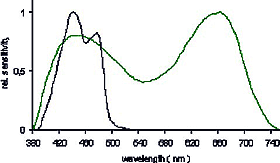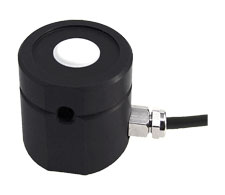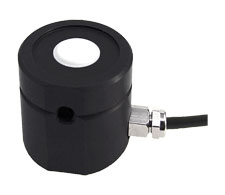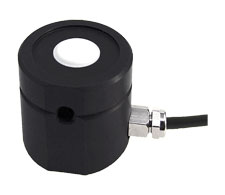VI.2. Plant physiology
The study and understanding of the interrelation of optical radiation and plants, seeds and soil is critically important for our existence. Research and control of biochemical factors require a precise and predictable measurement technology.
The absorption of optical radiation in the range of wavelengths between 300 nm and 930 nm initiates photochemical reactions in plants that are essential for plant growth. The three most important reactions of plants to optical radiation are: Photosynthesis, Phototropism, Photomorphogenesis
Photosynthesis
Photosynthesis is one of the most important biochemical processes on the planet. In the process of photosynthesis green plants absorb carbon dioxide from the atmosphere and water from the soil, combining them with the aid of radiation energy to build sugar, releasing oxygen and water into the atmosphere. This process can be described by the following assimilation formula:
The occurrence of photosynthesis in plants is characterized by the green color of their leaves. This is due to chlorophyll which is absorbed with the photosynthetically active radiation. Accordingly, the absorption of the quanta of radiation energy in the chlorophyll molecules raises the electrons to a higher energy state. As they return to their initial state, the energy released is converted into chemical energy.
In general plant physiology, the term Photosynthetically Active Radiation (PAR) refers to the radiation in the range of wavelengths between 400 nm and 720 nm. This is the energy that is absorbed by the assimilation pigments in blue-green algae, green algae and higher order plants. The wavelengths for the lower limit (400 nm) and an upper limit (720 nm) are not entirely rigid. Photosynthetic reactions have, for example, been established in some algae at wavelengths shorter than 400 nm. In general, the lower limit depends on the structure and the thickness of the leaf as well as on the chlorophyll content. Some research projects have shown 700 nm as the upper wavelength limit.
In DIN 5031, Part 10 (currently in the draft phase) the spectral response function for photosynthesis is defined, and this is illustrated graphically below. For plant physiology, this range can be divided into three narrower bands:
- 400 nm to 510 nm: strong light absorption by chlorophyll, high morphogenetic effect
- 510 nm to 610 nm: weak light absorption by chlorophyll, no morphogenetic effect
- 610 nm to 720 nm: strong light absorption by chlorophyll, high morphogenetic and ontogenetic effect
This response function can be considered as a mean spectral response function. A number of different investigations have shown that the spectral absorption spectra of various plant types can be very different. These differences can also occur, in a single plant, e.g. in leaves of different ages or with different thicknesses, chlorophyll content, etc.. It should also be noted that the spectral response function for photosynthesis is defined with avoidance of mutual cell shading, experimenting with a young, thin leaf or with a thin layer of algae suspension.
The spectral distribution of the response function for photosynthesis might give the impression that visible radiation in the green range centered around 550 nm contributes very little to the photosynthetic process, and therefore is of minor importance. Just the contrary has been demonstrated by experiment. It is precisely this green radiation that yields the greatest productivity and efficiency in densely populated arrangements of plants or in thick suspensions of micro-organisms. This discovery is important for investigations into the yields of plants in the lower layers of wooded areas or of greenhouse stocks, or in deep water (e.g. in sea plants).
Classical investigations into plant physiology have indicated that photosynthetic bacteria possess special pigments with strong absorption bands in vivo at 750 nm (chlorobium chlorophyll in the green chlorobacteria) or at 800, 850, 870 and 890 nm. In contrast to the blue-green algae, green algae and the higher plants, the absorption spectrum of the photosynthetic bacteria also extends into the UV region as far as about 300 nm.

Fig. VI.10. Phototropism (blue) & Photosynthesis (green)
Ultraviolet Radiation Effects
The weakening of the ozone layer has been discussed in public for more than a decade. It presents a serious challenge to plant physiology. Even above Europe, a reduction in the total amount of ozone of 3-6% per decade (since 1978) has been established, which correlates with a measured increase of up to 7% in the level of UV-B radiation in high alpine areas with clean air. In March of 1993 a 15% disappearance of ozone was observed, so that in general an increase in UV-B radiation must be expected.UV-B radiation penetrates the tissues and leads to molecular changes in DNA, proteins, lipids and phytohormones. At high levels of UV radiation, oxygen radicals are formed, leading to oxidation of proteins and lipids. The result of this is that growth, photosynthesis, and finally productivity and yield are impaired. Some field trials have provided evidence that in the presence of an ozone reduction of 25%, the UV-sensitive soy bean variety Essex, unlike the insensitive Williams variety, undergoes a reduction in photosynthesis, and therefore of yield, of up to 25%. This effect of UV-B radiation (280 nm-313.3 nm) is internationally known as "generalized plant damage", and is evaluated using the UV-B response function according to Caldwell. This GPD response function incorporates the degree of damage, linear growth, the cell division rate and other factors. So in the fields of plant physiology and crop cultivation it is necessary not only to investigate the positive photosynthetic effects of optical radiation, but also the negative effects, mostly due to UV radiation, if the activity and protection mechanisms of plants are to be understood and manipulated.
Phototropism
Phototropism describes the effect of optical radiation on the direction of plant growth. The regions of maximum effect lie in the blue range between 380 nm and 520 nm (see Fig.VI.10). Radiation can have the effect of causing parts of plants to move.
Photomorphogenesis
Photomorphogenesis describes the way in which plants are formed under the influence of optical radiation. Radiation in the red region of the spectrum encourages linear growth, while blue radiation yields small, strong plants. To be more precise, the ratio of the radiation intensities in the range of wavelengths from 690 nm to 780 nm (long wavelength red) to the range of wavelengths from 560 nm to 680 nm (short wavelength red) is of great importance for the plant's biological processes.
Measurement Aim, Measurement Methods
The photochemical processes involved in plant physiology are understood as quantum processes. Associated measuring techniques should also treat them as such. The most important measurements for plant physiology are:
• Analysis of the efficiency of energy conversions in photosynthesis
• Determination of the rate of photosynthesis (yield factor) when exposed to radiation sources having different emission spectra
• Comparison of the rate of photosynthesis in various plant types cultivated under various radiation conditions
• Determination of the protective mechanism and the stress processes of plants in relation to UV radiation and high levels of heat radiation (infrared radiation)
The effect of radiation of various wavelengths on the growth processes taking place within plants can be represented in a number of ways. The rate of photosynthesis is defined as the ratio of the quantity of assimilated carbon dioxide (CO2) molecules to a suitable radiation input quantity.
These quantities are:
• the irradiance in W/m2, i.e. the radiant power per unit area of the irradiated object
• or, alternatively, the photosynthetic photon irradiance Ep,sy. This magnitude is also frequently referred to as the quantum flux density.
Photosynthetic Photon Irradiance E p,sy
The radiation conditions used in determining the rate of photosynthesis and the photosynthetic potential of various plant or algae types are not the same in all research institutions. Results obtained under very different radiation conditions, using detector heads with non-uniform rectangular (radiometric) characteristics, and then relating them to one another, may lead to false conclusions. This is because the varying spectra of the radiation sources in use are ignored in obtaining the measurement.
The solution is to evaluate the irradiance with a sensor with an appropriate spectral response function. It is presently assumed that the number of light quanta absorbed is responsible for plant growth, which implies that it is quantum magnitudes effective in plant biology that need to be measured. The most important magnitude is the photosynthetic photon irradiance E p,sy.
The photosynthetic photon irradiance E p,sy is defined as follows:

where: E(ë) is the spectral irradiance of the light source
ë is the wavelength of the radiation
E p,sy (ë) is the spectral photon irradiance = number of photons per second, per unit area and wavelength.
h is Planck's constant
c is the velocity of light.
The unit of photosynthetic photon irradiance, E p,sy, is defined as follows:

where 1 E = 1 Mol = 6.02* 10 23 photons (the most commonly used unit is μMol s-1m-2).
The limits of integration need to be specified for integration according to the formula. If, for example, the photosynthetic photon irradiance is to be measured in the range of wavelengths between 400 nm and 700 nm, 320 nm and 500 nm and 590 nm to 900 nm, the integration is carried out in the corresponding spectral segments.
This numerical integration can be performed implicitly by means of an integral measuring head. Such a measuring head must, however, satisfy two important conditions:
◊ The incident radiation must be evaluated in accordance with the cosine of the angle of incidence, i.e. using a cosine diffuser
◊ The spectral sensitivity of the measuring head must be adapted to the l/lr function. lr is the reference wavelength, and for the 400-700 nm, 320-500 nm and 590-900 nm ranges it is always the upper limit wavelength, i.e. 700 nm, 500 nm and 900 nm.
The spectral sensitivity of the sensor should be zero outside the responsive spectral zone of interest.
Gigahertz Optik
Light meters for horticulture (PAR, UV and NIR)
Light meters for measuring horticultural lighting in terms of PAR, UV and NIR irradiance.
Find product information here.
Plant Physiology Irradiance Detectors
PS-37 Plant Physiology Irradiance Detectors include PAR photosynthetic active radiation, Photoprism blue response and Photomorphogenesis red spectral response detectors for a better match to the irradiation source spectra and the type of plant growth study.
 |
| PS-3701: PAR Irradiance Detector |
 |
| PS-3702: BLUE320-500 nm Plant Physiology Irradiance Detector |
 |
PS-3703: RED560-900 nm Plant Physiology Irradiance Detector |
Interested in discussing your horticultural light meter application?
Give us a call!

